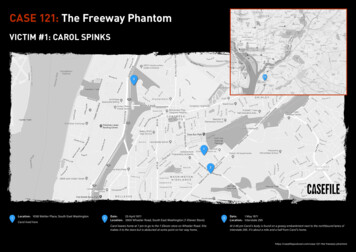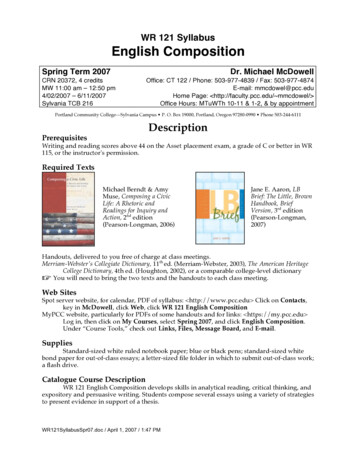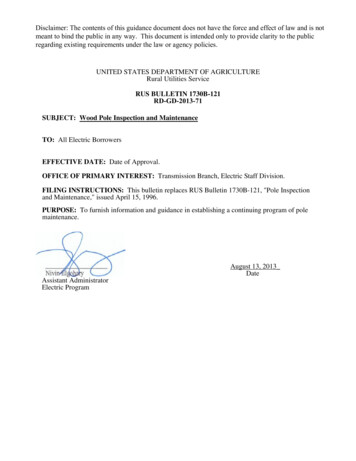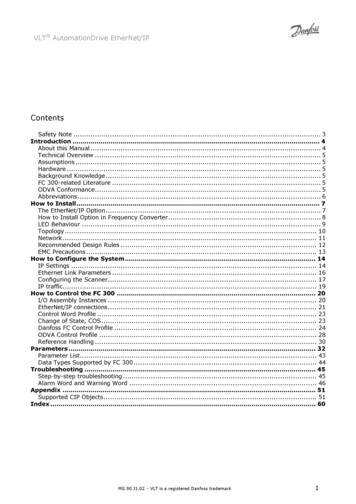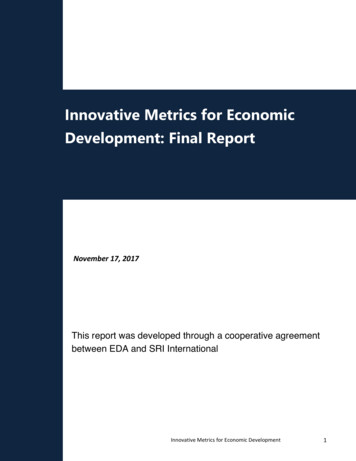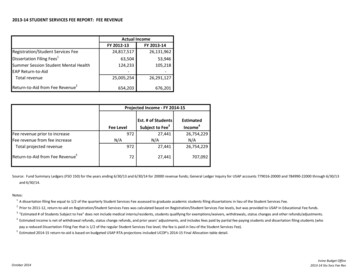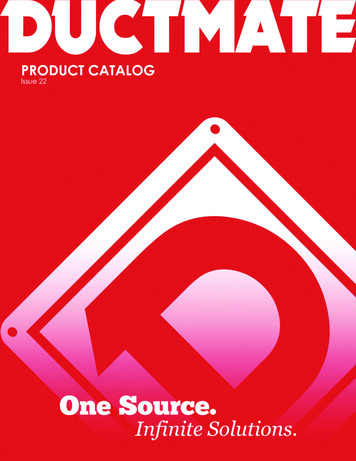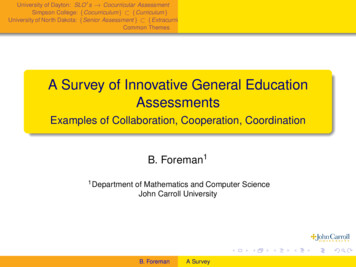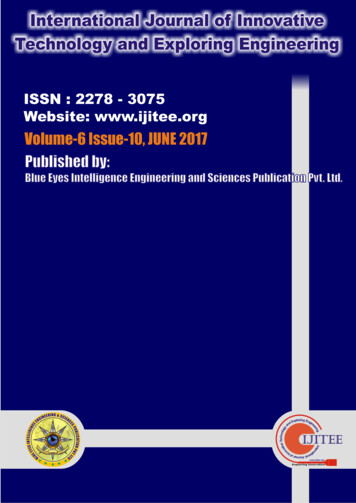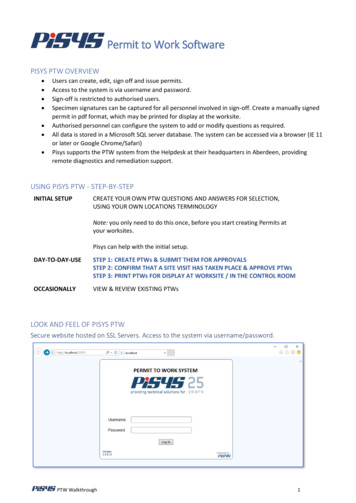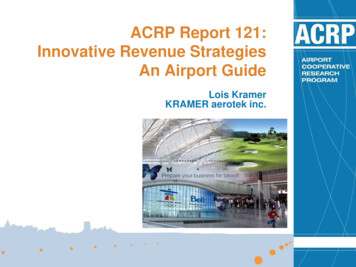
Transcription
ACRP Report 121:Innovative Revenue StrategiesAn Airport GuideLois KramerKRAMER aerotek inc.
Lois KramerPrincipal Investigator CEO of KRAMER aerotek inc.Airport Strategic Business PlansRevenue Development/DiversificationOpportunity AssessmentsTenant RetentionAirport Activity & Financial ForecastsOther ACRP Reports & Syntheses
ACRP Report 121 PanelHelen E. Berkman, Denver, (Chair)John W. Fuller, University of IowaBryan E. Johnson, Rocky Mountain Metropolitan AirportPaula Jordan, Dallas/Fort Worth International AirportA. Bradley Mims, PB Inc.Paul J. Wiedefeld, Maryland Aviation Administration, BWIGavin Fahnestock, FAA LiaisonBrett McAllister, ACI-na LiaisonLawrence D. Goldstein, ACRP Senior Program Officer
Expert BoardJohn Ackerman, Denver International/Dallas/Ft. WorthBruce Carter, Quad City InternationalRichard Chinsammy, Concessions Solutions GroupJanine Gervais, Toronto Pearson InternationalStephen Gordon, Oakland InternationalScott Kilgo, Portland InternationalAdeel Lari, University of MinnesotaWayne Pennell, Baltimore/Washington InternationalRick Piccolo, Sarasota-Bradenton InternationalLisa Stanton, Sacramento International
Project ObjectiveProduce a guide that will help airportprofessionals identify, evaluate, and implementinnovative strategies for generating revenues.Further project guidance .Characteristics ofInnovative Strategies In use by airports, butnot widely known Used by other modes orindustriesSources of NewRevenue Generation Airport users Entrepreneurial use ofairport assets Regional economy thatbenefits from airportTypes of Innovation New service concepts New customerinteractions New business products New net revenues tothe airport sponsor New delivery systems
Logic Behind the Research
The New Normal for AirportsEmbraces (and Requires) Change Innovative technology and its adoption is occurring atan accelerating pace Internet of Things, disruptive technologies, mobile apps Demand for change is coming from multiple directions,including: management, customers, the airlines other airport tenants, competing airports, & regulatory groups A steady stream of unexpected events contribute to anatmosphere of uncertainty Weather events, multi-country epidemics, terrorism Government funding levels & priorities
The Guide Presumes AirportsOperate As a Diversified Business Airport is a business that generates revenueby providing to a captured customer base.–––––Airline ServicesTraveler ServicesRetail ServicesExecutive and General AviationServices to Non-Aeronautical Airports may need to reduce dependence onaeronautical revenue and Federal grants
Ways to Improve RevenuesIncrease AirportSponsorRevenueParticipationRecover Costs &AchieveOperationalEfficiencies inExisting AirportBusinessesDevelop NewSources ofRevenueInnovativeStrategiesResults in Improvements toNet Revenues for the Airport Sponsor
Report Organization Guide organizes revenue techniques into 5 strategies– Customer experience, needs, and wants– Airport provided services/shared services,facilities, & equipment– Revenue participation in real estate & mineraldevelopment– Value capture– Improvements to existing businesses Guide also presents interesting case studies thatshow how use of these revenue techniques.Strategy DiscussionsElements of the StrategyTools and TechniquesEvaluationKey PointsSummary TablesAdditional References
How to Use the Guide All of the techniques (there are 96) are organized bystrategy and by functional areas of the airport. At the beginning there is a list of all techniquesdiscussed and at the back, an index with pagenumbers. Readers may want to read about a single strategyand all its elements, look up a case study, searchfor a particular technique, browse different ways toimprove revenue within a functional area of theairport (such as parking or terminal operations). Every airport will have a unique set of solutions.
Revenue Strategies
Strategy 1 - Customer FocusCustomerSegmentation Know the Airport's CustomersBetter MarketPenetration Target Specific Customer Groups Build Customer Relationships Generate New & Incremental RevenuePerformanceMeasurement Track Customer Satisfaction & AirportProfitabilityCost - Strategy Effectiveness – Priority General AviationCommercial AirportsAirports What do customers want?Suits on the FlyExperience SeekersSufferersGate PotatoesOpen-minded ChillersEmployees
Case Study – Indianapolis Int’lOptimizing Concession Programs As part of the new MidfieldTerminal Building,Indianapolis Airport Authority(IAA) took a new approach toits concession program. IAA directly recruited a mixof local and nationalconcessionairesManages the program witha few employees.Focus on customerexperience first, notrevenueInnovative approach tosolicitationIndividualized concessionagreementsExcellent and sustainedresults.
Strategy 2 – Airport ProvidedServices & Shared UseAirportProvidedServices Services provided to airport tenants andpassengers by the airport for profit.SharedServices Services shared through common providersto create critical mass and reduce the cost ofservices for all that participate.SharedFacilities,Systems, &Equipment Sharing and cross-utilization to improveefficiency and reduce user cost
Strategy 2 – ExamplesAirport Provided ServicesAirport TenantsLogistics Services & Warehousing for ConcessionairesTrash Removal & RecyclingGround HandlingAbove and Below the WingGlycol Recovery and RecyclingShared ServicesJanitorialJoint Marketing & AdvertisingShared Facilities, Systems, & EquipmentCommunications Systems & Cell Phone TowersConsolidated Air Cargo FacilityShared GatesEvaluated Potential for:Revenue ImprovementCost RecoveryOperational Efficiency
Case Study – Springfield-BransonGround Handling ServicesSGF owned and operatedthe FBO and fuel farm.Expanded to ground serviceswhen they could not secure aground handling contractor Airport purchased secondhand equipment and crossutilized airport staff Activity Results– More passengers– Air service retained– Charter activity Financial Results–––––Ground handling revenuesIncreased landing feesInto-plane chargesDe-icing salesIncreased PFCs and CFCs,parking revenues, rentalcar, and concessionrevenues
Strategy 3 – Revenue ParticipationReal Estate & Natural Resource Development Direct OwnershipParticipating Leases and Equity ParticipationPublic Private PartnershipsJoint DevelopmentMineral Estate Participating LeasesExtent ofAirport UseRevenuePotentialAirportAssumptionof RiskCapitalRequiredComplexityto ImplementPolitical &InstitutionalChallenges -
Case Study - Pittsburgh Int’lTIF Financing & Participatory LeaseThe Allegheny County Airport Authority (ACAA) faced astagnant real estate market.By utilizing creating financing,ACAA was able to jumpstartdevelopment activity ACAA entered into therisk sharing agreementwith a developer toconstruct a building onspec.ACAA used TaxIncrement Financing (TIF)to cover gaps in fundingfor needed infrastructure.The Authority offered lowinitial ground rent. Oncethe property was built andoccupied, ACAA shared inthe building rent.
Case Study - McCarran Int’lParticipatory Leasing ProgramClark County officialsacquired 5,226 acres ofland transferred from theBLM, much of which waslocated in the airport’snoise abatement zone. The Department of Aviation identified opportunities to developcertain parcels of land for commercial purposes.Local ordinances allowed the Department to participate inreal estate development in a manner similar to a joint venture.Several successful participatory leases were negotiated.
Strategy 4 – Value CaptureOff-Airport Beneficiaries Hotels and restaurantsRental carsParking lotsTravel plazas and gasstationsOffice buildingsWholesale tradeJust-in-time manufacturingTrucking and logisticsValue Capture Mechanisms Access and privilege feesFixed assessmentsTaxes or special allocations of tax receiptsBusiness improvement districtsAirport cities and foreign trade zones
Case Study - Boston Conventionand Exhibition CenterUse of value capturetechniques to help financea large project Multiple sources of funding-Hotel room occupancy taxSales taxMeal taxCar rental feesParking taxes/feesLand & water-based tourfee Special legislation required High level of cooperationfrom stakeholders whorecognized a commonpurpose and benefits ofthe project.
Case Study - DFW Foreign Trade Zone Airport spans 18,000 acresand 5 municipalities. FTZ illustrates how DFWcreates additional value fordevelopment in the vicinityof the airport. Example of how and airportsponsor and municipalitiescan implement multi-partyagreements to share taxrevenues.
Strategy 5 – Improvements toExisting Airport BusinessesElements of the Strategy Management alternativesProgram planning, document preparation,solicitation & awardPerformance improvementsUse of information technologyMonitoring performanceApplication of the Strategy to: Parking Rental Cars In-Terminal Concessions
Wrap Up
Concluding Thoughts Airports oversee a complex set of enterprises. Except at their largest connecting hubs, airlines aredepending more on airport sponsors and third partycontractors to provide ground support, passenger,processing, and baggage handling. Traditional sources of funding remain but levels areoften insufficient or timing is uncertain. Revenue strategies offer additional/incremental topay for maintenance, day-to-day operations, and capitalprojects.
The Intention of Report 121 is toInspire Innovation New net revenues can come from: Cost savings Improvements to existing airport businesses Airport engagement in new services and activity. Revenue strategies can be effective in every functionalarea of an airport. Strategy effectiveness requires airports to recognize andrespond nimbly to opportunities. Implementation is likely to be a continuous process ofincremental improvements. Every airport will have a unique set of solutions.
Project TeamLois S. KramerLois KramerKRAMER aerotek, Inc.Boulder, ColoradoSteven LandauEconomic Development Research GroupJeffrey LetwinSchnader Harrison Segal & Lewis LLPMichael MoroneyMichael G. Moroney & Associates
QuestionsCommentsDiscussionLois KramerKRAMER aerotek, Inc.info@krameraerotek.com303.247.1762
ACRP Report 141:Renewable Energyas an Airport Revenue SourceStephen B. Barrett, LEED-APHMMH
Stephen Barrett, LEED-APPrincipal Investigator Director of Climate and Energy, HMMH Principal Investigator for ACRP Report108, Guidebook for Energy FacilitiesCompatibility with Airports andAirspace (April 2014) Principal Investigator for ACRP Report151, Developing a Business Case forRenewable Energy at Airports (PrePublication Release, October 2015) Co-Author, FAA Solar Guide
ACRP Report 141Oversight PanelMeenakshi Singh, San Jose International Airport, Panel ChairmanDaniel P. Bartholomew, Reno-Tahoe Airport AuthorityRhona DiCamillo, DKMG Consulting, LLCJennifer M. Fuller, North Carolina DOTRobert M. Nicholas, Ithaca-Tompkins Regional AirportWilliam Shoard, Energy Efficiency GroupDavid Duchow, FAA LiaisonAneil Patel, ACI-NA LiaisonChristine Gerencher, TRB LiaisonJoseph Navarrete, ACRP Senior Program Officer
ACRP Report 141: Renewable Energy asan Airport Revenue Source Introduces renewable energy technologies to the aviationreaderSummarizes opportunities for and obstacles to deployingrenewable energy projects at airportsDescribes the typical renewable energy ownershipsscenarios and applicable financing optionsReviews the airport decision-making process for evaluatingand pursuing renewable energyIdentifies key stakeholders and their rolesProvides financial modeling tools to assess project costeffectivenessIncludes 21 Case Summaries of Airport Renewable Projects Published August 2015
Research ProblemAirports operate in a competitive environment; they needto be constantly looking for creative ways to increaserevenues and decrease costs.Advances in renewable energy technology presentopportunities to generate revenue and achieve costsavings.There are many airport renewable energy projects thatdemonstrate this opportunity, but the functional andfinancial information behind their success has notbeen documented for the industry.
Research ApproachDevelop general information on technical and financialaspects of renewable energy.Integrate that information into a familiar airport decisionmaking process.Research and summarize experience of specific airportrenewable energy projects to demonstrate practice.Provide practical reference materials for airports to usefor evaluating and implementing their own projects.
Results – Technologies
Results – Economic ValueState IncentivesREC ValueStable Energy Costs
Results – Business StructureAirport OwnedGrantsBondsGovernment CannotMonetize Tax Credits,Must Fund with GrantsEnergy savingsThird Party OwnedPrivate capitalTax equityLand, BuildingTax Credits availableto private parties,Savings passed toAirport and ElectricityBuyerReturn on Investmentfrom PPADiscounted energyor annual lease payment
Results – Projects at Airports
Results – Case Summaries
Action – State Project GoalLower existing energy costsDiversify revenuesDiversify energy supplyEnhance energy reliabilityPromote sustainability policy
Action – Identify AppropriateRenewable ResourceBiomassWind
Action – Determine Most CostEffective Business ModelAre you in a state with incentives?Can you consume all power produced?Is power cheap or expensive?Is the project grant eligible?
Action – Locate Appropriate SiteClose to electrical infrastructureAvoid causing glareConsistent with ALPNo impact to radarAvoid rare species
Action – Prepare Cost BenefitEstimate installed cost of projectEstimate annual operations and maintenance for life ofthe projectAirport owned project Build in financing costs Identify funds to construct Estimate annual savings to determine break evenThird party project Decrease project costs by value of available tax credit Incorporate investor rate of return to project cost Determine price of electricity that is economical
Action – ImplementationCoordinate with internal and external stakeholdersApply for grantsIssue RFP for renewable energyPermits and ApprovalsInterconnection Process with UtilityProject Management
Example 1 – San DiegoSolar PV on Terminaland over parkingOwned by Third PartyAirport buys allelectricity20 year contractPrice level for termPart of GreenBuildTerminalEnergy generation formicrogrid
Example 2 – Portland (ME)Ground source heatpumpPart of TerminalExpansion ProjectOwned by the AirportVale grants paid for81% of project costAnnual net costsavings of 160,000Airport’s sharepayback in 3.6 yearsMonitoring system
For additional information:ACRP Report 141:Renewable Energyas an AirportRevenue Sourcehttp://www.trb.org/Main/Blurbs/172634.aspx Stephen Barretto sbarrett@hmmh.com
Brett McAllister, ACI-na Liaison Lawrence D. Goldstein, ACRP Senior Program Officer . Bruce Carter, Quad City International Richard Chinsammy, Concessions Solutions Group Janine Gervais, Toronto Pearson International Stephen Gordon, Oakland International Scott Kilgo, Portland International . or annual lease payment . Results – Projects at .
